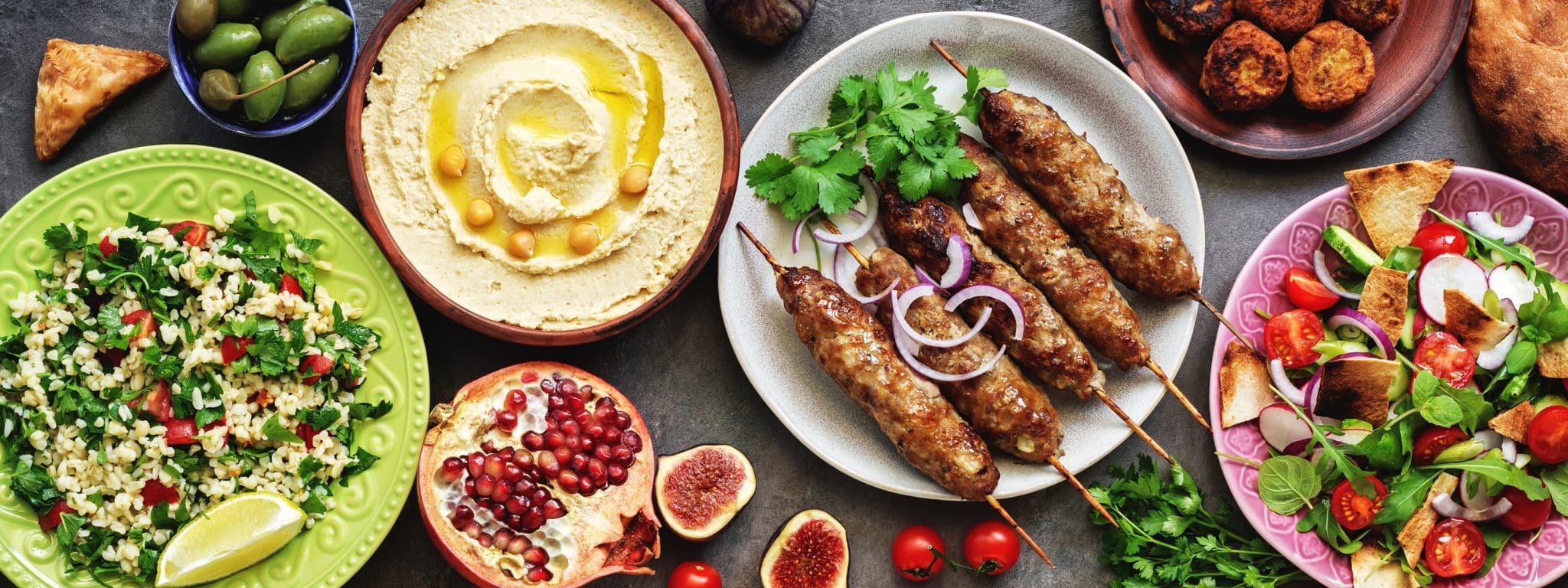Turkish food balances hearty, aromatic flavors with simplicity and seasonal ingredients. Proteins typically come from lamb, beef, and chicken—pork is not traditionally consumed for religious reasons—while seafood is more common along the Aegean and Black Sea coasts. Yogurt, legumes like lentils and chickpeas, and eggs also play major roles in providing protein across the country.
Endemic plants like sumac, thyme, and mint are used widely in both cooked and fresh preparations. Olive cultivation in the west supports a Mediterranean-style cuisine with olive oil–based dishes (zeytinyağlılar), while the wheat fields of central Anatolia have made flatbreads, bulgur, and pastries like börek central staples. Istanbul’s historical role as a global trade hub ensured the steady flow of spices, dried fruits, rice, and other luxury ingredients, all of which continue to enrich Turkish cooking.
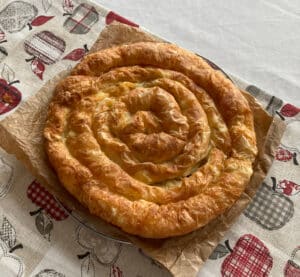
Culinary traditions in Turkey are also shaped by layers of cultural influence. Turkish food has absorbed elements from Arabic, Persian, Balkan, and Caucasian cuisines, while also influencing the cooking of neighboring regions and former Ottoman territories. Southeastern Turkey, especially cities like Gaziantep and Şanlıurfa, is home to some of the country’s most iconic and richly spiced dishes—thanks to its proximity to Levantine trade routes and Arab cultural zones. Meanwhile, the Aegean and Mediterranean coasts favor lighter fare with more seafood and fresh herbs, the Black Sea region features corn-based dishes and anchovies, and Central Anatolia emphasizes hearty stews and baked goods. Each region reflects not only its geography and local food sources but also its historical ties to different peoples and empires.
Below, each dish is listed in the Turkish original. If another common name is used in English, it is listed at the end of the entry in italics. Turkish cuisine is well known and, with the richness of its Ottoman heritage, highly developed. We have included many best-known dishes – but certainly not all.
Ali Nazik: (Main Dish)– A rich southeastern Turkish dish made with smoky, pureed eggplant mixed with yogurt, and topped with sautéed spiced lamb—either ground or cubed. It’s typically served with rice or flatbread. The dish originates from Gaziantep, and its name is tied to a local legend. During a 16th-century visit, Ottoman Sultan Yavuz Selim tasted the dish and asked, “Whose gentle hand (eli nazik) made this?” Over time, eli nazik evolved into ali nazik, giving the dish its name. (Ali Nazik)
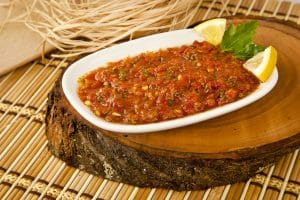
Acılı Ezme: (Starter) – A spicy, rich Turkish salad or meze, made with finely chopped tomatoes, onions, peppers, garlic, parsley, and seasoned with lemon juice, olive oil, and chili pepper paste. It’s commonly served as a starter alongside grilled meats or kebabs. (Spicy Tomato Salad)
Aşure: (Dessert) – A sweet, porridge-like dessert made from a mix of grains, legumes, dried fruits, and nuts. Prepared during the Islamic month of Muharram, it is also called “Noah’s Pudding” as it is believed that, after Noah landed his ark on Mount Ararat, he combined all his remaining foods to create a celebratory meal. (Noah’s Pudding)
Ayran: (Drink) A refreshing drink made with yogurt, water, and salt. Commonly served with kebabs and grilled dishes, it is sometimes called “Turkish beer” as practicing Muslims should not drink alcohol.
Börek: (Bread) Thin sheets of yufka (see below) are layered with filling such as white cheese, parsley, minced meat, onions, spinach, and/or potatoes. It can then be rolled or folded into various shapes like spirals or tubes or left flat before being baked or fried. Börek is a versatile dish eaten for breakfast, as a street food, or for celebratory meals. (Borek)
Boza: (Drink) A thick, sweet-and-sour fermented beverage made from grains like millet or bulgur. Traditionally consumed in winter, it is sometimes flavored with cinnamon and/or roasted chickpeas.
Balık Ekmek: (Main Dish) An iconic Istanbul street food, the name literally translates to “fish and bread.” Typically made with grilled or fried mackerel, served in crusty bread with lettuce, onions, and sometimes pickles or lemon. (Fish and Bread)
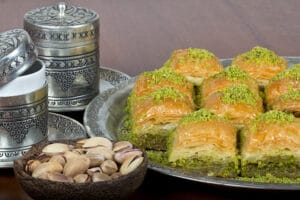
Baklava: (Dessert) A rich, layered pastry made with thin phyllo dough, filled with pistachios or walnuts, and soaked in syrup. Today a commonly eaten desert, it is also traditional for celebrations like Eid al-Fitr and weddings.
Bazlama: (Bread) – A thick, soft Turkish flatbread associated with the countryside. Made with yogurt or milk and leavened with yeast, it’s rolled into rounds and cooked in a pan. Often eaten warm for breakfast with butter or cheese.
Bergamot: (Ingredient) A type of orange, the bergamot is sometimes referred to as “sweet lemon.” It is used primarily for jams, marmalades, desserts, and to flavor teas such as Earl Grey. (Sweet Lemon)
Biber: (Seasoning; Ingredient) In Turkish, biber means “pepper” and refers to both the vegetable and related spices. Pul biber (red pepper flakes) and toz biber (ground red pepper) are essential to Turkish cuisine in both sweet (tatlı) and hot (acı) varieties. They are used in meats, meze, and soups. Biber salçası (pepper paste) is made by sun-drying or simmering a mix of sweet and hot pureed red peppers into a thick, concentrated paste used to add deep flavor and color to dishes like stews, ground meat dishes, rice dishes, and sauces. It can be sautéed with onions or garlic to create a flavor base for soups or sauces. Black pepper is “karabiber” (literally “blackpepper”) in Turkish. (Pepper)
Cacık: (Soup; Sauce; Side Dish) is a cold yogurt-based dish made by mixing yogurt with salt and water. Chopped cucumber, garlic, and dill (or mint) is added. Associated with summer, it is eaten as a soup, side, or dip finished with a drizzle of olive oil and/or ice cubes.
Cezve: (Cooking Technique) This long-handled, traditionally copper coffee pot was invented in the Ottoman Empire in the 16th century, not long after the Ottoman Empire conquered parts of what is today modern Yemen and gained access to coffee. The hourglass shape helps trap the crema, while the wide bottom, heated in sand, allows even, high heat and a high coffee-to-water ratio (1:7 as compared to 1:16 for most drip coffee machines), that makes türk kahvesi (see below) particularly flavorful and rich. (Turkish Coffee Pot)
Çay: (Drink) This cultural staple typically served in small, tulip-shaped glasses. Turks drink çay throughout the day, either straight, with a cube of sugar, or with a small sweet such as lokum (see below). Turkey’s Rize region is famed for growing much of Turkey’s supply of çay. (Turkish Tea).
Çaydanlık: (Cooking Technique) Çay is traditionally brewed in a çaydanlık, a two-tiered teapot where the top pot brews concentrated tea and the bottom heats water used to dilute the tea to taste. The design is derived from the Russian samovar, introduced to Turkey during the 19th-century Russo-Turkish War. Before this, coffee was the main beverage, but because coffee beans had to be imported while tea could be grown locally, many people began switching to tea during the war.
Çoban Salatası: (Salad) A light, refreshing salad made with chopped tomatoes, cucumber, onion, green pepper, and parsley, typically dressed with olive oil, salt, and lemon juice. The name translates to “shepherd’s salad,” as shepherds are known for quick, simple meals eaten with one eye on the flock. In fact, in Turkish, saying that “çoban gibi yiyor” (he/she is eating like a shepherd), means that that person is eating quickly. (Shepherd’s Salad)
Çörek otu: (Seasoning) Often mistaken for burnt sesame seeds, these have a peppery, slightly bitter, and earthy flavor. They are commonly sprinkled on savory pastries and breads like poğaça (see below) börek (see above). (Nigella Seeds)

Damla Sakızı: (Seasoning) The resin from the mastic tree has a pine-like, slightly sweet flavor. It is used in small amounts to flavor desserts like dondurma (Turkish ice cream) and muhallebi (milk pudding). It’s also used in select savory breads and drinks, prized for its aromatic intensity and chewiness when heated. (Mastic)
Dondurma: (Dairy) Turkey’s famous ice cream, is stretchy and chewy due to the addition of salep (orchid root flour) and sometimes damla sakızı (see above). Vendors often serve it with playful tricks that stretch, cut, and flip the ice cream. (Turkish Ice Cream)
Ezogelin Çorbası: (Soup) A spicy and filling soup made with red lentils, bulgur, rice, mint, paprika, and sometimes chili powder. It is named after a bride from Turkish mythology named Ezo, who invented the thick, rich, comforting soup to impress a demanding new mother-in-law. The soup is still associated with weddings and bringing luck to brides. (Ezogelin Soup)
Etli Dolma: (Main Dish) Vegetables like bell peppers, eggplants, or zucchinis are stuffed with a mixture of minced meat (usually lamb or beef), rice, onions, and warm spices like cinnamon or allspice and then simmered in a tomato-based sauce. (Stuffed Vegetables with Meat; see also Sarma, below).
Fattoush Salatası: (Salad) Popular especially in southern Turkey, this salad is made with mixed greens, tomatoes, cucumbers, radishes, herbs, and pieces of toasted or fried flatbread. It’s seasoned with olive oil, lemon juice, and ground sumac. (Fattoush Salad)
Halumi: (Dairy) This salty, semi-hard cheese originally from Cyprus is traditionally made from a mix of sheep’s and goat’s milk, although though cow’s milk is more commonly used today. Halumi has a high melting point, allowing it to be grilled or fried without losing its shape. It is served with salads, in sandwiches, or on its own as part of a meze spread or breakfast.
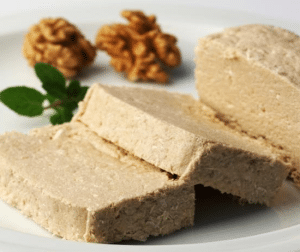
Helva: (Dessert) This dense, sweet confection has many regional variations across Eurasia. It is most commonly made with tahin (see below) along with sugar and a foaming agent such soapwort root to give it a crumbly, melt-in-your-mouth texture. Another version, irmik helvası, is made by toasting semolina in butter, then adding hot syrup, milk, pine nuts, and/or almonds. (Halva)
Hamsi Tava: (Main Dish) Small anchovies are dredged in cornmeal or flour and pan-fried until crispy. Popular on the Black Sea coast where anchovies are common. Served with rice, cornbread, and/or pickled vegetables. (Pan-Fried Anchovies)
Haydari: (Starter) Haydari is a thick and tangy yogurt-based dip made with labneh (see below), garlic, olive oil, and dried mint. It’s similar to, but saltier and denser than cacık (see above), and is commonly served as a meze or an accompaniment to meats or bread.
Hummus: (Starter) This creamy dip is made from cooked, mashed chickpeas blended with tahin (see below), garlic, lemon juice, and olive oil. While it’s common throughout the Middle East, Turkish variations may include yogurt or cumin and are often served as part of a meze spread. (Humus)

Hünkâr Beğendi: (Main Dish) Eggplants are roasted and mashed, then blended with milk, flour, and cheese (tulum or kaşar), to create a béchamel-like base, while the lamb is stewed with tomatoes, onions, and spices. It is said to have been created for and a favorite of Sultan Abdülaziz and it shows a blend of Turkish tradition and French influence, with elegant textures and rich, balanced flavors. (Sultan’s Delight)
İmam Bayıldı: (Starter) – Whole eggplants softened by frying or baking, then filled with a savory mix of onions, garlic, and tomatoes, all slowly cooked in olive oil. Served cold, it is especially popular in the Aegean region. Its name, meaning “the imam fainted,” is tied to stories of either the overwhelming flavor or the shock of using too much olive oil. (Imam Bayildi)
İskender Kebab: (Main Dish) A classic street food consisting of thinly sliced döner-style lamb over pita bread, topped with melted butter, tomato sauce, and yogurt. This rich, savory dish originated in 1867, when İskender Efendi of Bursa invented döner-style grilling, stacking meat vertically and slow-roasting it. Originally called “turning kebab,” because the mounted meat constantly turns, it became widely known as İskender Kebab in honor of its creator.
İçli Köfte: (Main Dish; Appetizer) Seasoned ground beef or lamb, onions, and pine nuts are stuffed into an oval-shaped outer dough shell made from fine bulgur mixed with flour and sometimes mashed potato. The dumplings are then either boiled or deep-fried. They are often served at celebratory dinners as a main course or an appetizer. (Stuffed Bulgur Balls)
İşkembe Çorbası: (Soup) Cleaned and boiled cow stomach is boiled until soft. The resulting soup is often thickened with flour or egg yolk and flavored with garlic, vinegar, and lemon. It’s a traditional hangover cure in Turkey and is a food that one either loves or avoids. (Tripe Soup)
Kaşar: (Dairy) A semi-hard yellow cheese made from cow, sheep, or mixed milk. Eski kaşar (aged kaşar) has a stronger, nuttier flavor, while taze kaşar (fresh kaşar) melts well and is used in sandwiches, on pide (see below) or baked dishes. (Kashkaval)
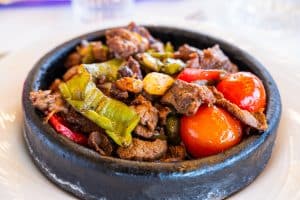
Kavurma: (Main Dish) Cubed lamb or beef is slow-cooked in its own fat with onions and spices like cumin, oregano, and red pepper flakes. Often prepared during Eid al-Adha, it is at once a festive and practical dish, associated with holidays for its richness but also often jarred as, if packed tightly, the meat will stay preserved in its own fat. It can then be set aside for winter and is commonly used as military rations. (Fried Meat)
Kaymak: (Dairy) A rich, clotted cream made by slowly simmering milk, then skimming and cooling the thick cream. It’s eaten with honey and bread at breakfast or served as a topping for desserts like baklava (see above) or künefe (see below).
Kuru Fasulye: (Main Dish) A national comfort food, this stew is made with white beans (such as navy or cannellini), onions, tomato paste, and olive oil or butter. It may also include cubes of beef or pastırma (see below) and is traditionally served with pilav (see below) and pickled vegetables. (Turkish Bean Stew).
Künefe: (Dessert) is a warm, syrup-soaked dessert made from kadayıf (shredded phyllo dough) layered with künefe peyniri (see below). Cooked til the outside is crisp, it is then doused in sugar-lemon syrup and topped with crushed pistachios. Served hot, typically with tea or coffee. (Kunefe)
Künefe Peyniri: (Dairy) This fresh, unsalted cheese is the namesake of künefe (see above). Made from cow’s or sheep’s milk, it has a soft, elastic texture and a very mild flavor that balances the sweetness of the syrup-soaked pastry. It stays stretchy and gooey when hot, making it essential to the distinctive texture of künefe and various pastries that are served warm.
Kuru Nane: (Seasoning) Dried mint is widely used in soups like yayla çorbası (see below), yogurt sauces, and meat marinades. For some dishes, it is sizzled briefly in hot oil or butter to release its aroma before being added. (Dried Mint)
Kimyon: (Seasoning) Provides a warm, earthy, somewhat smokey flavor to many meat-based dishes as well as savory vegetarian dishes such as mercimek köftesi (lentil patties) (Cumin)
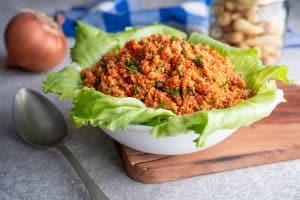
Kısır: (Starter) A flavorful and herby bulgur-based salad mixed with tomato paste, olive oil, and pomegranate molasses, chopped herbs (especially parsley and mint), and vegetables like cucumbers, scallions, and tomatoes. It’s typically served cold, often as part of a meze spread. (Tabbouleh)
Labneh: (Dairy) Made by draining yogurt through cheesecloth to remove the whey and leave behind a thick paste. It is used in dips, sauces, deserts, on sandwiches, eaten for breakfast, and much more.
Lahmacun: (Main Dish) A thin, crispy flatbread topped with minced meat (usually lamb or beef), onions, garlic, tomatoes, herbs, and spices like paprika and cumin. Usually eaten with lemon, fresh parsley, and raw onion.
Lavaş: (Bread) A soft, thin flatbread traditionally baked in a tandoor oven, which can often give it a slightly smokey flavor. It’s made from a simple dough of flour, water, salt, and yeast, rolled flat and cooked quickly. Commonly served alongside kebabs, used to wrap grilled meats and vegetables, or torn for dipping into meze. (Lavash)
Levrek Buğulama: (Main Dish) Steamed or lightly poached sea bass is prepared with onions, tomatoes, lemon, parsley, and olive oil. Common along the Aegean and Marmara coasts, its gentle cooking method preserves the delicate flavor of the fish.
Lokum: (Dessert) Sugar, water, and starch are mixed with flavors such as rosewater, citrus juice or zest, fruit extracts, or mastic resin and then boiled until it thickens into a gel-like consistency. Sometimes nuts are included inside or added, crushed, to the top. The candy is cut into cubes and dusted with powdered sugar or coconut to prevent sticking. Often served with Turkish coffee or tea. (Turkish Delight)
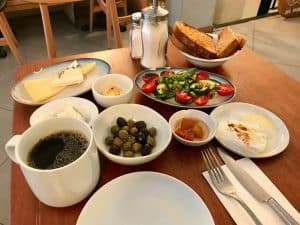
Lor: (Dairy) A soft, unsalted curd cheese made from the whey left over from other cheese-making. It resembles ricotta and is often used in pastries or desserts like lor tatlısı.
Mercimek Çorbası: (Soup) A smooth and hearty soup made with red lentils, onions, carrots, often simmered with cumin and mint, and then blended into a creamy texture. Served with a squeeze of lemon and a drizzle of melted butter best infused with red pepper flakes. A staple of Turkish homes. (Lentil Soup)
Mantı: (Main Dish) Small dough parcels filled with seasoned ground meat, usually lamb or beef, mixed with onions and spices. Typically served with yogurt and garlic sauce or melted butter infused with paprika or dried mint. Tiny and labor-intensive, they are often made for special occasions, with the whole family, young and old, helping to pinch them together. (Turkish Dumplings)
Meze: (Appetizers) A collection of small, flavorful dishes served as appetizers or shared plates. Turkish meze might include items like haydari (see above), hummus (see above), sarma (see below), halumi (see above), ali nazik (see above), acılı ezme (see above), patlıcan salatası (see below) and/or others, and often accompanied by lavaş (see above) and rakı (see below) They are meant to be enjoyed slowly in a social setting.
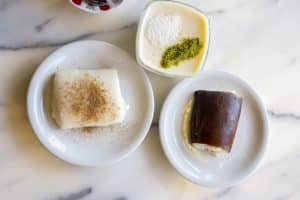
Muhallebi: (Desert) A creamy milk pudding made by cooking milk with sugar and rice flour or cornstarch. It is typically flavored with rosewater, orange blossom, salep (see below), or damla sakızı (see above) and served chilled, sometimes topped with cinnamon or crushed nuts. Light and mildly sweet, it’s a classic Turkish dessert dating back to the Ottoman era. (Milk Pudding)
Nar: (Snack; Ingredient) Better known abroad as pomegranates, these fruits have been cultivated in Anatolia for millennia and are a staple in Turkish cuisine. They are consumed as juice, garnish, nar ekşisi (pomegranate molasses), or plain as a fruit. The fresh seeds are sprinkled over dishes savory and sweet, while the thick, tangy molasses is used to add a sweet-sour flavor to both meat and vegetable dishes. (Pomegranate)
Pastırma: (Ingredient; Snack) Beef, thickly coated in a spiced paste made from fenugreek, garlic, and paprika is air-dried, cured, and aged, resulting in a flavorful, intensely spiced product similar to pastrami but uncooked. It’s thinly sliced and eaten on its own, in eggs (pastırmalı yumurta), or in savory pastries, particularly for breakfast or a snack. (Turkish Pastrami)
Patlıcan: (Ingredient) Eggplant has been a staple of Turkish cuisine since at least the 16th century. A South Asian vegetable, it and many other ingredients and spices listed here are a testament to the power and reach of Ottoman networks of cultural and economic exchange. Valued for its versatility and ability to absorb flavors, eggplant is prepared in Turkish cuisine in countless creative ways from flame grilled to fried to baked and from stuffed with meat to layered with other vegetables. (Eggplant)
Patlıcan Salatası: (Salad) Roasted until charred, eggplant is peeled, mashed, and mixed with garlic and olive oil. Often served cold as a meze. (Eggplant Salad)
Pide: (Bread) A traditional Turkish flatbread dish pide features a thin, boat-shaped dough filled with toppings such as cheese, minced meat, sucuk (see above), and/or vegetables, then baked until crisp. Some regional varieties add a cracked egg on top.
Pideli Ekmek: (Bread) Called a “pide,” but differing from all others, this Ramadan pide is round, soft, and does not feature fillings. Instead, it is topped with egg wash and sesame and/or nigella seeds and scored to create a diamond pattern. It’s traditionally baked and consumed during Ramadan and enjoyed warm with iftar meals. (Ramadan Pide).
Pilav: (Side or Main Dish) Rice in Turkish cuisine is typically cooked with butter or oil, often lightly toasted before simmering in broth for added flavor. Variants include şehriyeli pilav (with orzo), etli pilav (with meat), tavuklu pilav (with chicken), or versions with nuts and dried fruits. It is a staple side dish and accompanies a wide range of main courses.
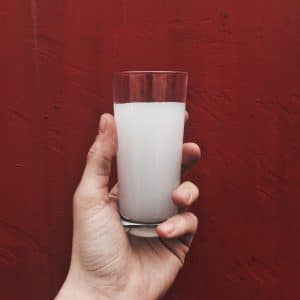
Rakı: (Spirit) Made from distilled grapes or raisins and flavored with aniseed, Turkey’s national tipple is usually served in a tall glass with water and ice, which turns it cloudy and white due to a process called the louche effect. Often called “lion’s milk” (aslan sütü) for its color, rakı is meant to be enjoyed with conversation and shared plates of meze. (Lion’s Milk; Raki)
Salep: (Drink) Salep is a warm, creamy winter drink made from the powdered root of wild orchids, mixed with milk, sugar, and sometimes cinnamon. Salep also refers to the orchid starch itself, which has been used in deserts like muhallebi (see above) and dondurma (see above) as a thickening agent and favor additive. In the winter drink, the root imparts a distinctive floral aroma and thick, velvety texture. While still sold by street vendors during cold months, salep is becoming rarer as growing and harvesting the wild orchid sustainably is difficult. (Salep)
Simit: (Bread) Simit is a circular sesame-crusted bread. Made from a yeasted dough, it’s dipped in a mixture of water and grape molasses before being rolled in sesame seeds and baked. A popular street food, it’s often eaten with tea, cheese, or olives for breakfast or a snack. (Turkish Bagel)
Sulu Köfte: (Main Dish) Meatballs made of ground beef or lamb, mixed with rice, herbs, and spices, are simmered in a light tomato-based broth with potatoes, carrots, and sometimes peas. It’s a comforting, home-cooked dish often served with bread or rice on the side. (Meatballs in Broth)
Sumak: (Seasoning) A tangy, deep red spice made from ground sumac berries. Commonly sprinkled over salads, especially with onions. Provides color as well as a sourness that balances rich or fatty dishes. (Sumac)
Sütlaç: (Dessert) A rice pudding made by simmering rice in milk and sugar until thick and creamy. Sometimes flavored with vanilla or orange zest and baked briefly for a golden top in a version known as “fırın sütlaç.” Served chilled or warm. (Rice Pudding)
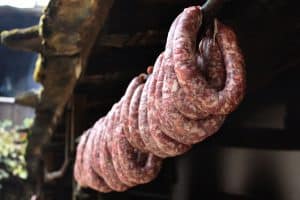
Sucuk: (Ingredient; Snack) A spicy, cured sausage made from ground beef (sometimes mixed with lamb), garlic, salt, and a rich blend of spices including cumin, paprika, and red pepper flakes. It’s sliced and fried for breakfast, mixed into eggs, or added to stews, or used to top bread.
Şalgam: (Drink) A fermented, savory beverage made from black carrots, turnips, bulgur flour, and salt water, often spiced with hot red pepper. Popular in southern Turkey, especially Adana. A pungent drink, it’s commonly served cold alongside kebabs and rakı to cleanse the palate. (Fermented Turnip Juice).
Susam: (Seasoning) Sesame seeds have a nutty, slightly sweet flavor and are widely used in Turkish pastries, breads, and sweets to add texture and aroma. Tahin (see below) is also used in dishes like helva (see above) and sauces.
Tarhana Çorbası: (Soup) Made from a fermented mixture of yogurt, flour, and vegetables that is then dried. This can then be stored and later added to boiled in water or broth for a tangy, nourishing soup. Especially associated with rural households in winter. (Tarhana Soup)
Tarçın: (Seasoning) Cinnamon is used for both sweet and savory dishes in Turkey. In meat-based stews, rice dishes, and stuffed vegetables like etli dolma, it’s used sparingly to add complexity without overpowering, often paired with allspice and pine nuts. (Cinnamon).
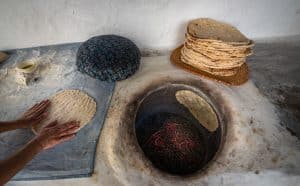
Tandır: (Cooking Technique) This clay or earthen oven is used for baking bread and roasting meat, especially in eastern and southeastern Turkey. Heat radiates from the walls of the oven, allowing flatbreads like lavaş (see above) or whole marinated meats to cook evenly at high temperatures while developing a smoky, charred flavor and tender texture. (Tandoor)
Tas: (Cooking Technique) This deep metal bowl or pot is inverted over food like a dome while cooking. This technique traps steam and moisture, allowing the ingredients (typically meat) to cook slowly in their own juices, resulting in tender, flavorful dishes like tas kebabı. It emphasizes slow simmering and minimal liquid to intensify natural flavors.
Tas Kebabı: (Main Dish) A classic Ottoman-style stew made with cubed beef or lamb, slowly braised with onions, tomatoes, and aromatic spices like cinnamon and allspice. The name comes from the traditional method of cooking it a tas cover (see above), which helps trap steam and enhance flavor. It’s served over rice or mashed potatoes, making for a rich, hearty dish. (Tas Kebabi)
Tavuk Suyu Çorbası: (Soup) A soup made with shredded chicken, rice or noodles, and sometimes egg yolk added for richness. Commonly served with lemon juice and black pepper for extra flavor. When sick, Turks take a light version with just broth. (Chicken Broth Soup)
Tulum: (Dairy) A traditional Turkish cheese usually made from goat’s or sheep’s milk and aged inside a goat-skin bag (with which it shares its name). This unique aging process gives the cheese a crumbly texture and a sharp, tangy flavor. It is commonly eaten with bread, sprinkled over salads, or paired with hearty dishes.

Türk Kahvesi: (Drink) – Finely ground coffee with water and sugar (optional) is boiled in a small pot called a cezve (see above). The thick, strong coffee is poured unfiltered into a small cup, leaving thick grounds at the bottom, and is often served with a glass of water and a piece of lokum (see above). Known for its strong flavor and rich foam, it’s both a beverage and a cultural ritual. (Turkish Coffee).
Yayla Çorbası: This comforting yogurt-based soup is flavored with dried mint and often thickened with rice or bulgur. It’s prepared by heating yogurt with egg and flour, gently to prevent curdling, then combining it with cooked grains and finishing with a sizzling butter–mint drizzle. (Highland Soup)
Yufka: (Bread) A thin, unleavened flatbread or pastry dough similar to phyllo, used in many traditional Turkish dishes. It’s layered and filled in savory dishes like börek (see above), or used to wrap fillings in gözleme (see above) in rolls or pies. (Turkish Flatbread)
Yeni Bahar: (Seasoning) A signature spice of Ottoman cuisine, allspice is made from the dried berries of the Pimenta dioica tree, native to the Caribbean and Central America, and indicating the historic importance of Istanbul as a major world trading hub. It offers a blend of flavors of cinnamon, nutmeg, and clove, all in one spice. It is most often used in savory dishes like dolma, içli köfte, as well as meat marinades and rice dishes. (All Spice)
You’ll Also Love
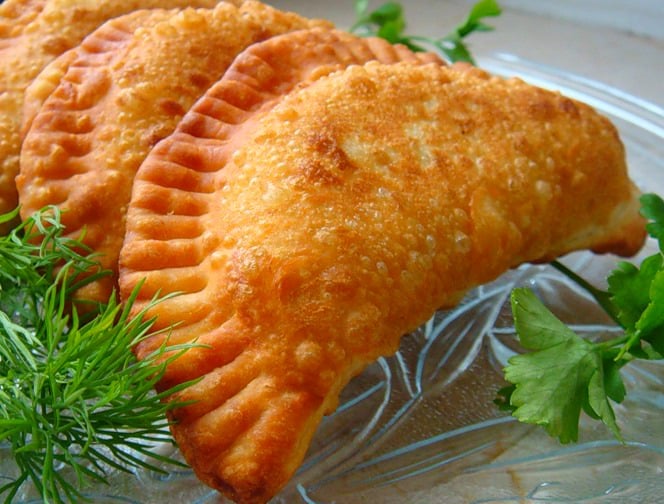
Cheburek: The Half-moon Pastry from Crimea
On streets throughout the post-Soviet space, you can generally find the “чебурек” (cheburek) — a juicy, fried, savory pastry — for sale. This tasty treat likely originated in Turkey or Crimea and its popularity slowly traveled north and eventually spread throughout what is today the former USSR. Why It’s Called “Cheburek” (Почему они носят такое […]
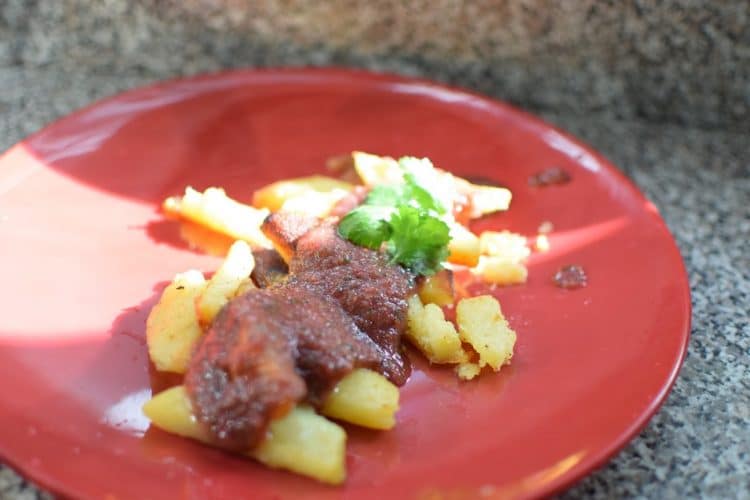
Tkemali: Georgian Sour Plum Sauce
Dr. Michael Denner (notes from the American Test Kitchen): Georgians jokingly refer to tkemali (more accurately written t’q’emali) as “Georgian ketchup.” It gets poured on practically everything. I don’t know of another sauce like it: sour, fruity, salty, with a serious herbal punch and a bit of lingering heat. Maybe it looks like Mexican salsa […]
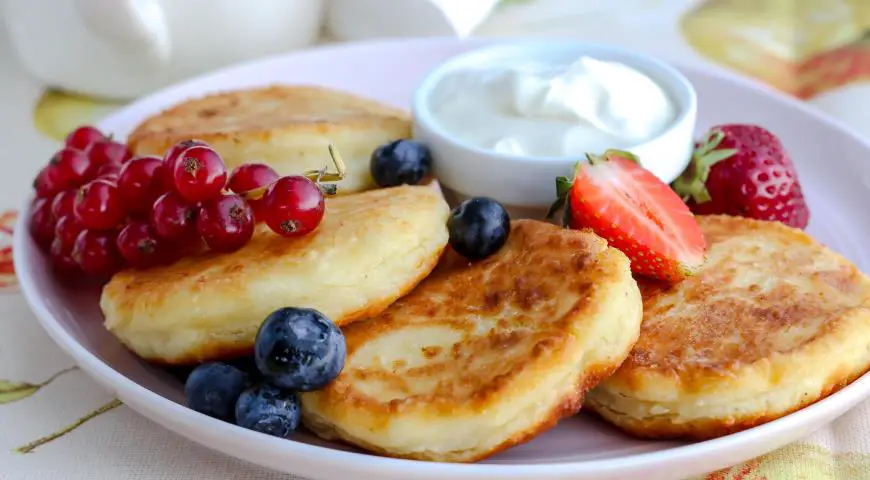
Syrniki: Not Your Average Cheese Cake
Syrniki (Сырники) are cottage cheese griddle cakes, sometimes called “cheese fritters” in English. They are generally fried in vegetable oil to create crispy-on-the-outside, soft-on-the-inside medallions of warm, creamy goodness. Drizzled with sour cream, condensed milk, and/or jam, and served for breakfast or dessert, syrniki are particularly beloved in Russia, Ukraine, Poland, Belarus, and the Baltics. […]
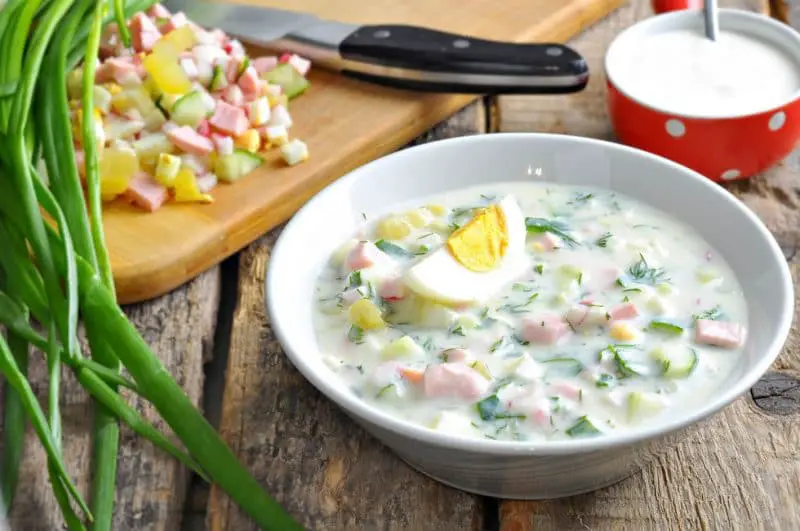
Okroshka: A Refreshing Summer Soup
Okroshka (Окрошка) is a cold soup that probably originated in the Volga region of Russia. Because of its light, refreshing taste, it is popularly served in summer. The soup usually consists of diced vegetables, eggs, and meats in a base of either kvass or kefir and is often garnished with sour cream. Best known in […]
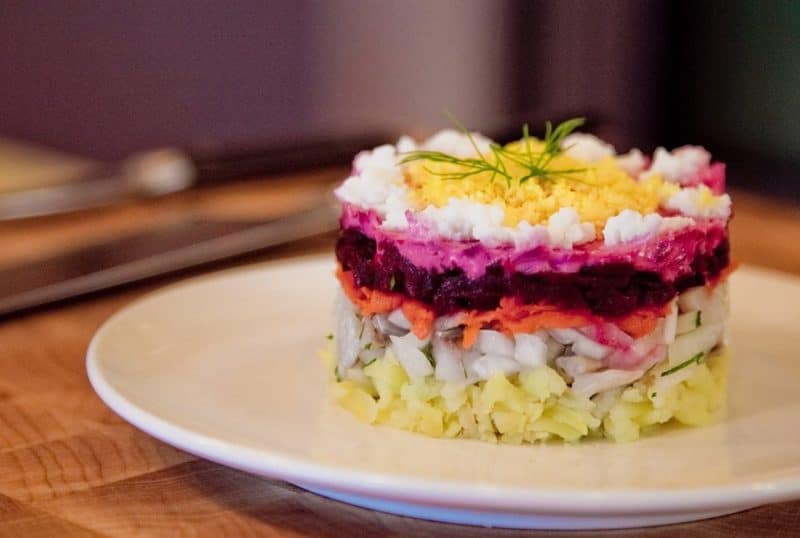
Herring Under A Fur Coat: A Hearty New Year’s Tradition
Potatoes, herring, beets, and mayonnaise come together to create the beloved Herring under a Fur Coat (селёдка под шубой), served at nearly every special occasion in the post-Soviet space. It was first seen in the early days of the Soviet Union. However, what is most unusual about the salad is its bright purple color, which […]

